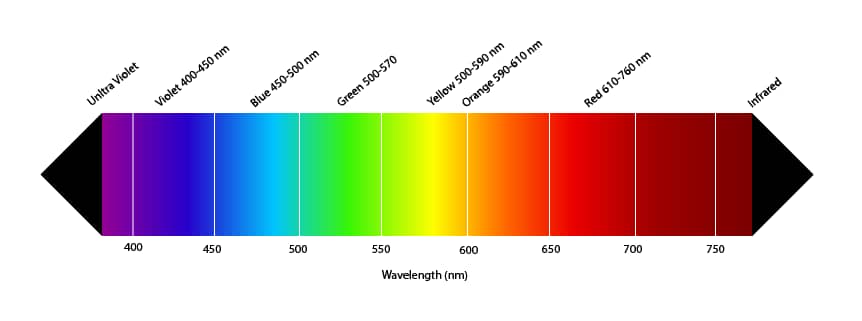Blog
Colour temperature of light explained
Light colour temperature is a measure of the hue or “warmth” of a light source. It is measured in units called Kelvin (K) and represents the temperature of an ideal blackbody radiator that emits light of a similar hue to the light source being measured.
Below is an image showing the visible colours in the spectrum, with their wavelengths. Shorter wavelengths are on the left-hand side and start at ultraviolet – very popular in nightclubs back in the 1990s! As the wavelengths increase the colours move through the visible colour range to red and then infrared which we are unable to see.

The image shows the colour at each wavelength and not the result of a mixture of wavelengths, so there are no shades of colours in the chart, and no white either.
Because of this the CIE (International Commission on Illumination, abbreviated from its French title) researched the colour space (shown in the image below), showing all visible colours. The wavelengths are shown around the outside, and the colours merge towards the middle where they are shown as white. It is placed on a grid background so that all colours can be referenced by coordinates if required.

In addition to white, the chart shows the “black body locus” – the black line that you can see curving through the middle of the chart.
The black body locus is a line through the colours that a black body (we can think of it as a lump of metal, for ease of understanding) will go through as it’s heated up.
As it warms up, it will start off a dull red, before moving through to orange, yellow, white and then blue hot. This is what we refer to as colour temperature. It feels slightly contradictory, as the lower the value, the warmer (more orange) the light is. The higher the colour temperature, the cooler (bluer) the light is.

Warmer temperatures are on the left-hand side, with a lower kelvin value, cooler colour temperatures are on the right-hand side, with a higher kelvin value.
Lighting guides specify office lighting to be 4000K in the UK – this is perceived as neither warm nor cool, and because of this it is often referred to as “neutral white”.
Some parts of an office may have warmer lighting – breakout spaces for example, as the warmer colours can make an area feel more relaxed and informal.
The change of colour temperature throughout the day, from the warmth of sunrise, through to the cool of midday, then warming up at sunset will be a topic on its own in a future post dealing with circadian lighting. It will cover how we can, and why we may want to, replicate that changing colour temperature with tuneable white luminaires.
We hope you have found this helpful. For any questions or comments, feel free to Contact Us



